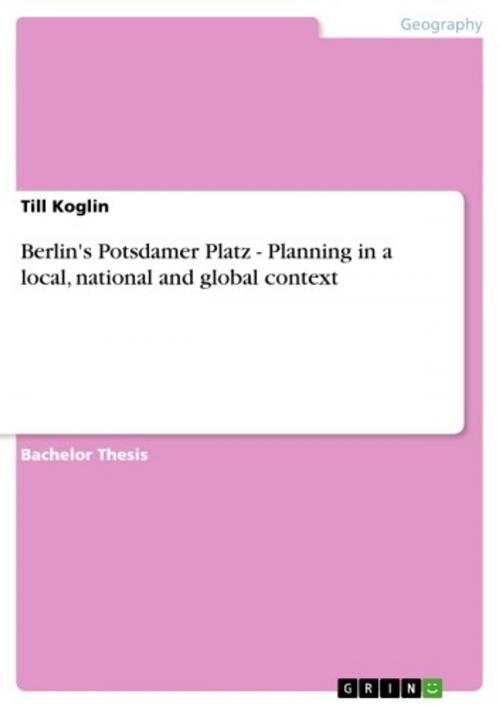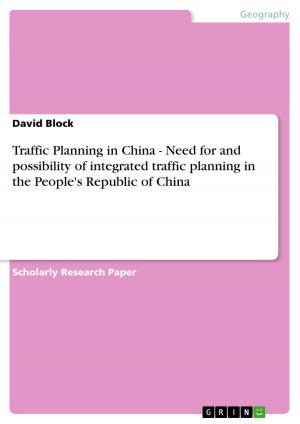Berlin's Potsdamer Platz - Planning in a local, national and global context
Planning in a local, national and global context
Nonfiction, Science & Nature, Science, Earth Sciences, Geography| Author: | Till Koglin | ISBN: | 9783638689595 |
| Publisher: | GRIN Publishing | Publication: | June 5, 2007 |
| Imprint: | GRIN Publishing | Language: | English |
| Author: | Till Koglin |
| ISBN: | 9783638689595 |
| Publisher: | GRIN Publishing |
| Publication: | June 5, 2007 |
| Imprint: | GRIN Publishing |
| Language: | English |
Bachelor Thesis from the year 2007 in the subject Geography / Earth Science - Demographics, Urban Management, Planning, grade: High Pass, Lunds Universität (Institut für Kulturgeographie und Wirtschaftsgeographie), 39 entries in the bibliography, language: English, abstract: The move of the capital city from Bonn to Berlin in Germany was highly debated in both the daily press and in the academic world after the Berlin Wall came down in 1989. Germany was reunified and somehow a new country. The building of the new German capital Berlin is also strongly discussed. Berlin became a place for renewal and city development. During the 1990s and in the beginning of the new millennium Berlin went through many different development projects like the renewal of the Friedrichstraße in East Berlin and the development of the new/old government quarter (Regierungsviertel). The Potsdamer Platz is just another place of the places discussed in Germany. The case of Berlin as a new German identity or the face of a newly reunified Germany, features prominently in different academic journals. Despite that is the issue of people's identification with places and the identity of space along with gentrification and planning are issued in some theoretical discussions through out the academic world. Identity, power and public places along with planning are issues that are very important, when it comes to Berlin and the new Germany. Berlin's development is very interesting to analyse, because Berlin and the development or redevelopment deals with different aspects of Germany's history as well as with economic or social aspects. The decision of the German government to move the German capital from Bonn to Berlin was very important for Berlin's development as the new/old capital city of Germany and the federal government invested heavily on the redevelopment of Berlin (Heineberg 2001: 236-238). Dealing with 20th-century history is understandably a very sensitive issue in Germany. Berlin has tried to do that in different ways, for example by the exhibitions in the German Historical Museum (see Till 2001 Reimagining National Identiy) or the building of different monuments dedicated to the victims of the Nazi terror or the DDR regime, but they have not been without critique (see Wiese 1998: 145-156 or Marcuse 1998). The aims of this thesis are to take a closer look at the process of planning a new German capital city and to make sense of a place that is highly discussed in academic articles. I want to find out what plans are behind the new Potsdamer Platz and what was the purpose of these plans. What impression does the place Potsdamer Platz give.
Bachelor Thesis from the year 2007 in the subject Geography / Earth Science - Demographics, Urban Management, Planning, grade: High Pass, Lunds Universität (Institut für Kulturgeographie und Wirtschaftsgeographie), 39 entries in the bibliography, language: English, abstract: The move of the capital city from Bonn to Berlin in Germany was highly debated in both the daily press and in the academic world after the Berlin Wall came down in 1989. Germany was reunified and somehow a new country. The building of the new German capital Berlin is also strongly discussed. Berlin became a place for renewal and city development. During the 1990s and in the beginning of the new millennium Berlin went through many different development projects like the renewal of the Friedrichstraße in East Berlin and the development of the new/old government quarter (Regierungsviertel). The Potsdamer Platz is just another place of the places discussed in Germany. The case of Berlin as a new German identity or the face of a newly reunified Germany, features prominently in different academic journals. Despite that is the issue of people's identification with places and the identity of space along with gentrification and planning are issued in some theoretical discussions through out the academic world. Identity, power and public places along with planning are issues that are very important, when it comes to Berlin and the new Germany. Berlin's development is very interesting to analyse, because Berlin and the development or redevelopment deals with different aspects of Germany's history as well as with economic or social aspects. The decision of the German government to move the German capital from Bonn to Berlin was very important for Berlin's development as the new/old capital city of Germany and the federal government invested heavily on the redevelopment of Berlin (Heineberg 2001: 236-238). Dealing with 20th-century history is understandably a very sensitive issue in Germany. Berlin has tried to do that in different ways, for example by the exhibitions in the German Historical Museum (see Till 2001 Reimagining National Identiy) or the building of different monuments dedicated to the victims of the Nazi terror or the DDR regime, but they have not been without critique (see Wiese 1998: 145-156 or Marcuse 1998). The aims of this thesis are to take a closer look at the process of planning a new German capital city and to make sense of a place that is highly discussed in academic articles. I want to find out what plans are behind the new Potsdamer Platz and what was the purpose of these plans. What impression does the place Potsdamer Platz give.















